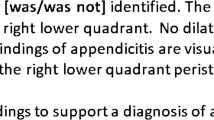Abstract
Background
The use of ultrasound to diagnose appendicitis in children is well-documented but not universally employed outside of pediatric academic centers, especially in the United States. Various obstacles make it difficult for institutions and radiologists to abandon a successful and accurate CT-based imaging protocol in favor of a US-based protocol.
Objective
To describe how we overcame barriers to implementing a US-based appendicitis protocol among a large group of nonacademic private-practice pediatric radiologists while maintaining diagnostic accuracy and decreasing medical costs.
Materials and methods
A multidisciplinary team of physicians (pediatric surgery, pediatric emergency medicine and pediatric radiology) approved an imaging protocol using US as the primary modality to evaluate suspected appendicitis with CT for equivocal cases. The protocol addressed potential bias against US and accommodated for institutional limitations of radiologist and sonographer experience and availability. Radiologists coded US reports according to the probability of appendicitis. Radiology reports were compared with clinical outcomes to assess diagnostic accuracy. During the study period, physicians from each group were apprised of the interim US protocol accuracy results. Problematic cases were discussed openly.
Results
A total of 512 children were enrolled and underwent US for evaluation of appendicitis over a 30-month period. Diagnostic accuracy was comparable to published results for combined US/CT protocols. Comparing the first 12 months to the last 12 months of the study period, the proportion of children achieving an unequivocal US result increased from 30% (51/169) to 53% (149/282) and the proportion of children undergoing surgery based solely on US findings increased from 55% (23/42) to 84% (92/109). Overall, 63% (325/512) of patients in the protocol did not require a CT. Total patient costs were reduced by $30,182 annually.
Conclusion
We overcame several barriers to implementing a US protocol. During the study period our ability to visualize the appendix with US increased and utilization of CT decreased. Our overall diagnostic accuracy with the US-based protocol was comparable to other published results and remained unchanged throughout the study.




Similar content being viewed by others
References
Holscher H, Heij H (2009) Imaging of acute appendicitis in children: EU versus US … or US versus CT? A European perspective. Pediatr Radiol 39:497–499
Hryhorczuk A, Mannix R, Taylor G (2012) Pediatric abdominal pain: use of imaging in the emergency department of the United States from 1999 to 2007. Radiology 263:778–785
Sivit C, Applegate K, Stallion A et al (2000) Imaging evaluation of suspected appendicitis in a pediatric population: effectiveness of sonography versus CT. AJR Am J Roentgenol 175:977–980
Garcia Pena B, Taylor G, Fishman S et al (2000) Costs and effectiveness of ultrasonography and limited computed tomography for diagnosing appendicitis in children. Pediatrics 106:672–676
Krishnamoorthi R, Ramarajan N, Wang N et al (2011) Effectiveness of a staged US and CT protocol for the diagnosis of appendicitis in children: reducing radiation exposure in the age of ALARA. Radiology 259:231–239
Pearce M, Salotti J, Little M (2012) Radiation exposure from CT scans in childhood and subsequent risk of leukaemia and brain tumors: a retrospective cohort study. Lancet 380:499–505
Doria A, Moineddin R, Kellenberger C et al (2006) US or CT for diagnosis of appendicitis in children and adults: a meta-analysis. Radiology 241:83–94
Smith-Bindman R, Miglioretti D, Johnson E (2012) Use of diagnostic imaging studies and associated radiation exposure for patients enrolled in large integrated health care systems, 1996–2010. JAMA 307:2400–2409
Larson D, Johnson L, Schnell B et al (2011) Rising use of CT in child visits to the emergency department in the United States, 2005–2008. Radiology 259:793–801
Burr A, Renaud E, Manno M et al (2011) Glowing in the dark: time of day as a determinant of radiographic imaging in the evaluation of abdominal pain in children. J Pediatr Surg 46:188–191
Hernandez JA, Swischuk LE, Angel CA et al (2005) Imaging of acute appendicitis: US as the primary imaging modality. Pediatr Radiol 35:392–395
Saito J, Yan Y, Evashwick T et al (2013) Use and accuracy of diagnostic imaging by hospital type in pediatric appendicitis. Pediatrics 131:e37–e44
Wan M, Krahn M, Ungar W (2009) acute appendicitis in young children: cost-effectiveness of us versus ct in diagnosis — a Markov decision analytic model. Radiology 250:378–386
Acknowledgments
We express our thanks to the pediatric sonographers whose expertise and dedication to pediatric imaging made this manuscript possible: Sandi Arnberg, RDMS; Carly Durrant, RDMS; Sasha Gordon, RDMS, RVT; Kandus Johnson, RDMS; Marie Newton, RDMS, RVT; Kim Nowicki, RDMS, RVT; Jeremy Olson, RDMS, RVT; Brad Watts, RDMS.
Conflicts of interest
None
Author information
Authors and Affiliations
Corresponding author
Rights and permissions
About this article
Cite this article
van Atta, A.J., Baskin, H.J., Maves, C.K. et al. Implementing an ultrasound-based protocol for diagnosingappendicitis while maintaining diagnostic accuracy. Pediatr Radiol 45, 678–685 (2015). https://doi.org/10.1007/s00247-014-3220-9
Received:
Revised:
Accepted:
Published:
Issue Date:
DOI: https://doi.org/10.1007/s00247-014-3220-9




